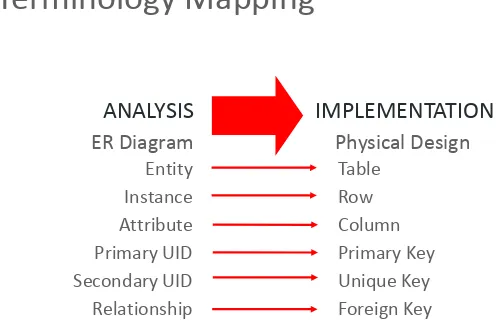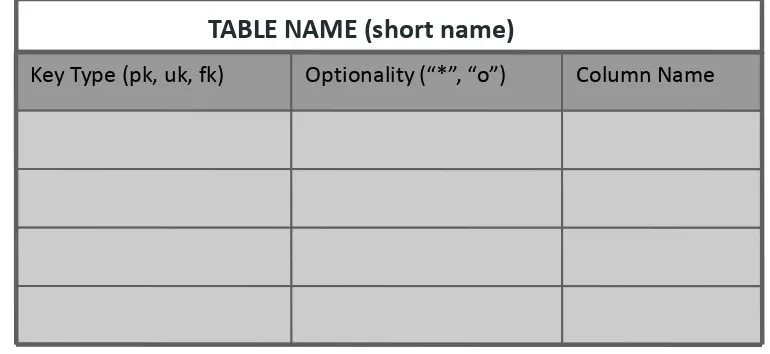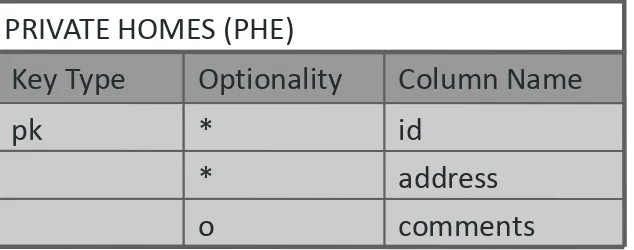Database Design
9-2Copyright © 2015, Oracle and/or its affiliates. All rights reserved.
DDS9L2
Basic Mapping: The Transformation Process
Objectives
This lesson covers the following objectives:
• Distinguish between a conceptual model and a physical
model
• Apply terminology mapping between the two models
• Understand and apply the Oracle naming conventions for
tables and columns used in physical models
• Transform an entity into a table diagram
Purpose
• When you design a house, you eventually would like to see
the house built.
• Even if you don’t do the actual construction, you will need to
understand the terms used by the builders in order to help them take your conceptual design and make it a physical reality.
• The initial database design can be used for further discussion
between designers, database administrators, and application developers.
Copyright © 2015, Oracle and/or its affiliates. All rights reserved.
DDS9L2
Basic Mapping: The Transformation Process
Review of Relational Tables
• A table is a simple structure in which data is organized and
stored.
• In the example below, the EMPLOYEES table is used to store
employees’ information.
Neil 90386
22 NEIL
LOUNGANI 378
Chaz 52
10 CARLOS
GOMEZ 405
Larry 1101
10 LAWRENCE
CHEN
NICKNAME PAYROLL_ID
DEPARTMENT_ID FIRST_NAME
LAST_NAME EMPLOYEE_ID
rows
Primary Key Column (PK)
Foreign Key Column (FK)
Unique Key Column (UK)
Table: EMPLOYEES
columns
5
Review of Relational Tables
• Tables have columns and rows.
• In the example, each row describes an occurrence of an
employee.
Neil 90386
22 NEIL
LOUNGANI 378
Chaz 52
10 CARLOS
GOMEZ 405
Larry 1101
10 LAWRENCE
CHEN
NICKNAME PAYROLL_ID
DEPARTMENT_ID FIRST_NAME
LAST_NAME EMPLOYEE_ID
rows
Primary Key Column (PK)
Foreign Key Column (FK)
Unique Key Column (UK)
Table: EMPLOYEES
Copyright © 2015, Oracle and/or its affiliates. All rights reserved.
DDS9L2
Basic Mapping: The Transformation Process
Review of Relational Tables
• Each column is used to store a specific type of value, such as
employee number, last name, and first name.
• The employee_id column is a primary key.
7
Neil 90386
22 NEIL
LOUNGANI 378
Chaz 52
10 CARLOS
GOMEZ 405
Larry 1101
10 LAWRENCE
CHEN
NICKNAME PAYROLL_ID
DEPARTMENT_ID FIRST_NAME
LAST_NAME EMPLOYEE_ID
rows
Primary Key Column (PK)
Foreign Key Column (FK)
Unique Key Column (UK)
Table: EMPLOYEES
Review of Relational Tables
• Every employee has a unique identification number in this
table.
• The value in the primary key column distinguishes each
individual row.
Neil 90386
22 NEIL
LOUNGANI 378
Chaz 52
10 CARLOS
GOMEZ 405
Larry 1101
10 LAWRENCE
CHEN
NICKNAME PAYROLL_ID
DEPARTMENT_ID FIRST_NAME
LAST_NAME EMPLOYEE_ID
rows
Primary Key Column (PK)
Foreign Key Column (FK)
Unique Key Column (UK)
Table: EMPLOYEES
Copyright © 2015, Oracle and/or its affiliates. All rights reserved.
DDS9L2
Basic Mapping: The Transformation Process
Review of Relational Tables
• The payroll_id is a unique key.
• This means that the system does not allow two rows with the
same payroll_id.
9
Neil 90386
22 NEIL
LOUNGANI 378
Chaz 52
10 CARLOS
GOMEZ 405
Larry 1101
10 LAWRENCE
CHEN
NICKNAME PAYROLL_ID
DEPARTMENT_ID FIRST_NAME
LAST_NAME EMPLOYEE_ID
rows
Primary Key Column (PK)
Foreign Key Column (FK)
Unique Key Column (UK)
Table: EMPLOYEES
Review of Relational Tables
• The foreign key column refers to a column in another table.
• In this example, the department_id refers to a column in the
DEPARTMENTS table.
Neil 90386
22 NEIL
LOUNGANI 378
Chaz 52
10 CARLOS
GOMEZ 405
Larry 1101
10 LAWRENCE
CHEN
NICKNAME PAYROLL_ID
DEPARTMENT_ID FIRST_NAME
LAST_NAME EMPLOYEE_ID
rows
Primary Key Column (PK)
Foreign Key Column (FK)
Unique Key Column (UK)
Table: EMPLOYEES
Copyright © 2015, Oracle and/or its affiliates. All rights reserved.
DDS9L2
Basic Mapping: The Transformation Process
Review of Relational Tables
• We know that Dana Smith works in department 10.
• If we wanted to know more about Dana Smith’s department,
we would look for the row in the DEPARTMENTS table that has department_id = 10.
11
Neil 90386
22 NEIL
LOUNGANI 378
Chaz 52
10 CARLOS
GOMEZ 405
Larry 1101
10 LAWRENCE
CHEN
NICKNAME PAYROLL_ID
DEPARTMENT_ID FIRST_NAME
LAST_NAME EMPLOYEE_ID
rows
Primary Key Column (PK)
Foreign Key Column (FK)
Unique Key Column (UK)
Table: EMPLOYEES
columns
Transforming Conceptual To Physical
• The conceptual model (ER diagram) is transformed into a
physical model.
Copyright © 2015, Oracle and/or its affiliates. All rights reserved.
DDS9L2
Basic Mapping: The Transformation Process
Transforming Conceptual To Physical
EMPLOYEE # employee id * first name * last name * payroll id o nickname
DEPARTMENT # department id * department name
department_name *
department_id *
pk
Column name Optionality
Key type
DEPARTMENTS (DPT)
department_id *
fk
nickname o
first_name *
last_name
*
payroll_id *
uk
employee_id *
pk
Column name Optionality
Key type
EMPLOYEES (EPE)
Conceptual Model (ERD)
Physical Implementation: Relational Database
Transformation process
Terminology Mapping
• Changing from analysis (conceptual model) to
implementation (physical model) also means changing terminology:
– An entity becomes a table.
– An instance becomes a row.
– An attribute becomes a column.
– A primary unique identifier becomes a primary key.
– A secondary unique identifier becomes a unique key.
Copyright © 2015, Oracle and/or its affiliates. All rights reserved.
DDS9L2
Basic Mapping: The Transformation Process
Terminology Mapping
ANALYSIS ER Diagram
IMPLEMENTATION Physical Design
Entity Instance Attribute Primary UID Secondary UID Relationship
Table Row Column
Primary Key Unique Key Foreign Key
Table Diagram Notations
• The first row of the table diagram contains the table name
and the short name.
• The Key Type column should contain values of “pk” for the
primary key, “uk” for the unique key, and “fk” for the foreign-key column.
Column Name Optionality (“*”, “o”)
Key Type (pk, uk, fk)
Copyright © 2015, Oracle and/or its affiliates. All rights reserved.
DDS9L2
Basic Mapping: The Transformation Process
Table Diagram Notations
• It will be blank if the column is not a part of any key.
• The Optionality column must contain “*” if the column is
mandatory and “o” if it is optional. This is similar to the entity diagram. The third column is for the column name.
Column Name Optionality (“*”, “o”)
Key Type (pk, uk, fk)
TABLE NAME (short name)
Naming Conventions for Tables and
Columns
• The table name is the plural of the entity name.
• Example: STUDENT becomes STUDENTS
dob *
p_code *
state *
city *
str_addr *
last_name *
first_name *
id *
pk
Column Name Optionality
Key Type
STUDENT
# id
* first name
* last name
* street address
* city
* state
* postal code
* date of birth
Copyright © 2015, Oracle and/or its affiliates. All rights reserved.
DDS9L2
Basic Mapping: The Transformation Process
Naming Conventions for Tables and
Columns
• Column names are identical to the attribute names except
that special characters and spaces are replaced with underscores.
19
dob *
p_code *
state *
city *
str_addr *
last_name *
first_name *
id *
pk
Column Name Optionality
Key Type
STUDENT
# id
* first name
* last name
* street address
* city
* state
* postal code
* date of birth
Naming Conventions for Tables and
Columns
• Column names often use more abbreviations than attribute
names. Example: first name becomes first_name, or fname
dob *
p_code *
state *
city *
str_addr *
last_name *
first_name *
id *
pk
Column Name Optionality
Key Type
STUDENT
# id
* first name
* last name
* street address
* city
* state
* postal code
* date of birth
Copyright © 2015, Oracle and/or its affiliates. All rights reserved.
DDS9L2
Basic Mapping: The Transformation Process
Table Short Names
• A unique short name for every table is useful in the naming of
foreign-key columns.
• One possible way to make these short names is based on the
following rules:
• For entity names of more than one word, take the:
– First character of the first word
– First character of the second word
– Last character of the last word
• Example: JOB ASSIGNMENT gets a short name of JAT
Table Short Names
comments o
address *
id *
pk
Column Name Optionality
Key Type
PRIVATE HOME # id
* address o comments
Copyright © 2015, Oracle and/or its affiliates. All rights reserved.
DDS9L2
Basic Mapping: The Transformation Process
Table Short Names
• For entity names of one word but more than one syllable,
take the:
– First character of the first syllable
– First character of the second syllable
– Last character of the last syllable
• Example: EMPLOYEE gets a short name of EPE and CLIENT
gets a short name of CET
Table Short Names
email_addr o
phone_num *
last_name *
first_name *
client_num *
pk
Column Name Optionality
Key Type CLIENTS (CET)
CLIENT # number * first name * last name
Copyright © 2015, Oracle and/or its affiliates. All rights reserved.
DDS9L2
Basic Mapping: The Transformation Process
Table Short Names
• For entity names of one syllable but more than one character:
– First character
– Second character
– Last character
• Example: FLIGHT gets a short name of FLT
description
*
code *
pk
Column Name Optionality
Key Type
THEME # code
* description
THEMES (THE)
Naming Restrictions with Oracle
Table and column names:
• Must start with a letter
• Can contain up to 30 alphanumeric characters
• Cannot contain spaces or special characters such as “!,” but
“$,” “#,” and “_” are permitted.
• Table names must be unique within one user account in the
Oracle database.
Copyright © 2015, Oracle and/or its affiliates. All rights reserved.
DDS9L2
Basic Mapping: The Transformation Process
Naming Restrictions with Oracle
• Some words have a special meaning in the Oracle database
and in the SQL programming language.
• These are called “reserved” words.
• It is best to avoid using these as names for your tables and
columns.
Naming Restrictions with Oracle
• Some common examples of Oracle reserved words are:
– TABLE
– NUMBER
– SEQUENCE
– ORDER
– VALUES
– LEVEL
– TYPE
Copyright © 2015, Oracle and/or its affiliates. All rights reserved.
DDS9L2
Basic Mapping: The Transformation Process
Terminology
Key terms used in this lesson included:
• Map
• Reserved word
• Transform
Summary
In this lesson, you should have learned how to:
• Distinguish between a conceptual model and a physical
model
• Apply terminology mapping between the two models
• Understand and apply the Oracle naming conventions for
tables and columns used in physical models




